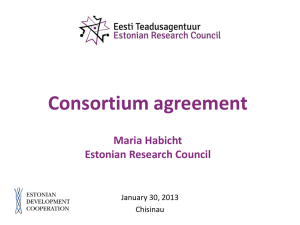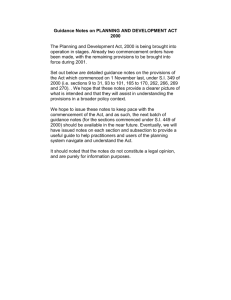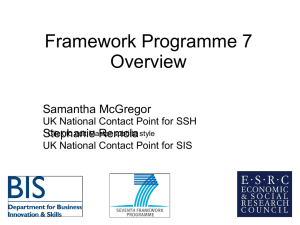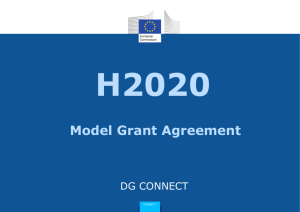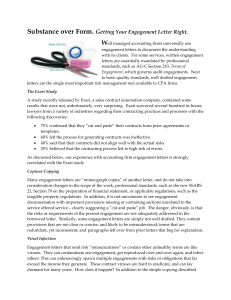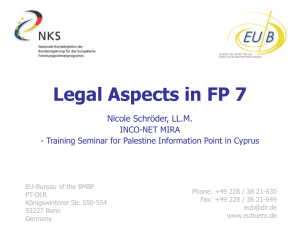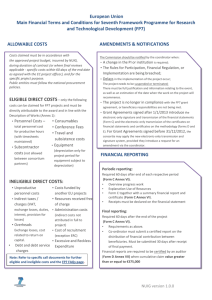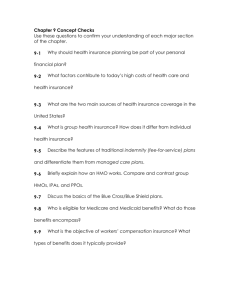Enterprise Ireland Presentation
advertisement
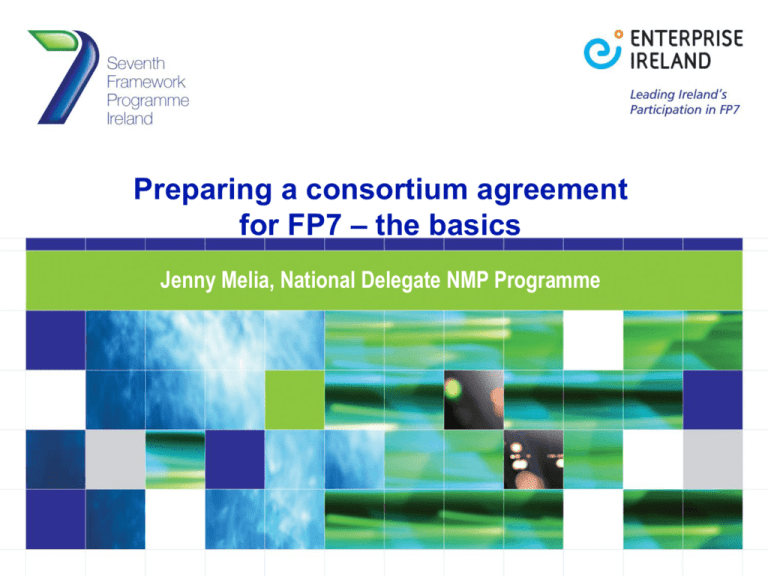
Preparing a consortium agreement for FP7 – the basics Jenny Melia, National Delegate NMP Programme Overview What is covered by a ‘typical’ consortium agreement Model FP7 agreements available Checklist for developing a consortium agreement Common mistakes & pitfalls (FP6) What is a consortium agreement (CA) The CA is an agreement made between participants to govern a number of issues that will or may arise during the project. It applies to all the contractors participating in the project covered by the contract. The Community is not a party to any CA and does not establish the terms and conditions of the CA but it issues guidelines for development In principle, the CA should in principle be negotiated and signed before starting the project. A consortium agreement is required for all projects financed under FP7 except those exempted from this obligation by the call for proposals to which they have applied. What does the consortium agreement govern? 1. General Information on project 2. Technical Provisions and the internal organisation of the consortium 3. Financial and Legal Provisions 4. Management of Intellectual Property Rights 5. The settlement of internal disputes. Defined by the Rules for Participation and the EC Grant Agreement for the implementation of FP7. It must comply with these documents. Outline of typical CA (based on FP6) General information and conditions, Definitions Technical provisions Technical contribution of each party (as set out in Annex 1) Technical resources made available Project Schedule Expected contribution, maximum effort expected Modification procedure Provisions for dealing with non-performing contractor (s) Outline of typical CA (based on FP6) Commercial provisions Confidentiality Ownership of results / joint ownership of results / difficult cases (background knowledge that is very closely linked to the result, making it difficult to distinguish the background from the result) Legal protection of results (patent rights) Commercial exploitation of results and any necessary access rights Commercial obligations Relevant patents, know-how, and information Sub-licensing Specific background to include for/exclude from use in the project? Outline of typical CA (based on FP6) Organisational provisions Committees – establishment, composition, procedures, role and nature: Steering, management, technical, IPR, financial etc; Co-ordination of committees Amendment / revision of the agreement Legal provisions Legal form of the co-operation Duration of the agreement versus duration of the EC contract Penalties for non-compliance with obligations under the agreement Applicable law and the settlement of disputes Secondment of personnel Outline of typical CA (based on FP6) Financial provisions Financing plan Modification procedure Mutual payments, common costs Distribution of management costs Auditing of costs Audit certificates Provisions for dealing with non-performing contractor(s) Third party resources - identifying parties and resources General Introduction Who are the partners, what’s the context and purpose of the CA? Project title, acronym, contract no. (if available) Contract definition and additional definitions Terms of agreement; from date to date, retrospective? Subject:: Annex 1 (Technical Annex) or key points (Definitions: defines the important terms used throughout the CA (for the sake of clarity, it is advisable that those terms already defined in the Rules for Participation or the EC Grant Agreement are not repeated in the CA but that a reference is made to the terms used in those documents) The internal organisation of the consortium Management and operation of the project Functions of coordinator Roles and responsibilities of management and steering group and /or board Responsibilities of each partner Meetings, Technical & Financial reports Communication, Information Exchange, Supervision Internal disputes amongst the consortium What to do it a partner doesn’t perform, wants to leave early, goes bankrupt, replace partners, add new partners, partner wishes to block a publication? Technical Provisions Tasks to be undertaken by each partner and relationship between tasks Technical resources to be made available Project schedule and dealing with changes such as altering or removing tasks Desired technical results Role of Subcontractors All of the above are captured in Annex 1 Financial Provisions Overall project total Total cost per partner; own + EC contribution How will EC’s contribution be distributed? Dealing with common expenses 3rd party resources (Banks, VCs) Annual financial plan Define costs to be claimed under management (GA) Financial modifications Management of Intellectual Property Rights How will the Foreground knowledge be managed, disseminated, used? Ownership, Joint ownership Who is responsible for dissemination, notice period, vetting procedures etc? Transferring to other parties Protection & Use (security) Access Rights (can be more favourable than GA) Define conditions for further use, time limits Background Knowledge (can be more favourable than GA) What will be included, excluded? Conditions General Provisions When does the CA start and end? How to deal with amendments? Breach of obligations and penalties, liability for damage caused Communication and applicable law Confidentiality procedures Which provisions outlive the CA? How often will the CA be updated? Model agreements available DESCA FP7 IMG EUCAR Sector specific Open access foreground FP6 CAs EICTA: European ICT Industry Association EUCAR: Automotive Industry IMG: Aerospace Industry DESCA: DEsign of a Simplified Consortium Agreement Produce one consistent modular agreement for FP7 which balances the interests of all key player categories, in the spirit of “Responsible Partnering” Based on FP6 NoE CA www.desca-fp7.eu Number of FP6 coordinators e.g. CNRS, Fraunhofer, VTT Available without charge Adapt the original DESCA texts to meet your specific needs Continually updated, Version 1 now available online Simple language Number of modules and examples, Core text and explanations Caters for large and small projects, RO’s and Enterprise Draft Checklist for a consortium agreement Non-binding guidance for FP7 projects Prepared by the Commission Highlights main issues – 11 parts Version 19/04/07 currently available ftp://ftp.cordis.europa.eu/pub/fp7/docs/checklist_en.pdf Common mistakes Where something basic in the CA is not in line with the EC contract e.g. conflict regarding publications, project trying to speed things up Unclear definitions e.g. ‘exceptional circumstances’ Background knowledge Inform Commission as well as the other contractors if you decide not to protect knowledge Duration of access rights Use of results: refers to economic exploitation of the results and to their utilisation in further research activities http://www.ipr-helpdesk.org In Summary Get started straight away Use model agreements available and FP7 checklist Draw up a model CA for large and small project Double check with your legal dept. Refine
